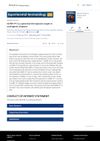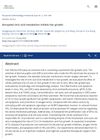IGFBP‐rP1 is a potential therapeutic target in androgenic alopecia Research/Science 10/28/2024
IGFBP‐rP1 shows potential for treating androgenic alopecia by influencing hair cycle transitions. Increasing IGF-1 levels may have similar effects to Minoxidil and 5-AR inhibitors in reducing hair loss.
View this post in the Community →
Similar Community Posts Join
5 / 6 results
community Compressed part of research of theory of androgenic/anabolitic balance. AGA h-responders analytic. Theory of physio-metabolitic method of anti AGA treatment
The treatment for androgenetic alopecia involves using finasteride and minoxidil with intense exercise and cold exposure to boost metabolism and reduce androgenic effects, potentially leading to hair regrowth. This approach may activate biological pathways for improved hair and overall health.
community How does dutasteride regrowth work?
A 25-year-old man with hair loss from bleach damage is using oral minoxidil and considering adding Dutasteride for better regrowth and prevention. He seeks advice on Dutasteride's effectiveness and potential benefits over finasteride, and is also curious about RU58841.
community Physio-metabolic method (antiandrogen, minoxidil, leg training and cold)
The method combines finasteride, minoxidil, intense leg exercises, and cold exposure to treat androgenetic alopecia. It aims to boost metabolism and reduce androgenic effects, enhancing hair growth.
community Stop expecting results in 2 months!
People discussing hair loss treatments emphasize the need for patience, as results from using finasteride and minoxidil can take 8-12 months or longer. Some users report early signs of improvement, while others experience continued shedding or slower progress.
community 22 yr asian male 2 year fin results
The user "Top_Replacement_7777" shared their positive results with finasteride for hair loss. They asked about maintaining their hair with finasteride and the impact of vaping on hair growth. Another user reassured them that vaping wouldn't affect their progress.
Related Research
6 / 474 results
research Migration Inhibitory Factor in Conditioned Medium from Human Umbilical Cord Blood-Derived Mesenchymal Stromal Cells Stimulates Hair Growth
Substance from human umbilical cord blood cells promotes hair growth.

research IGFBP-rP1 Is a Potential Therapeutic Target in Androgenic Alopecia
IGFBP-rP1 could be a new treatment for a common type of hair loss.
research Immune and Non-Immune Interactions in the Pathogenesis of Androgenetic Alopecia

research Disrupted Citric Acid Metabolism Inhibits Hair Growth
Disrupted citric acid metabolism stops hair growth.
research Cortisol Enhances the Expression of mac25/Insulin-Like Growth Factor-Binding Protein-Related Protein-1 in Cultured Osteoblasts
Cortisol increases a specific protein in bone cells, which may help explain its negative effects on bone.

research The Hedgehog-GLI1 Pathway Is Important for Fibroproliferative Properties in Keloids and as a Candidate Therapeutic Target
Targeting the HEDGEHOG-GLI1 pathway could help treat keloids.